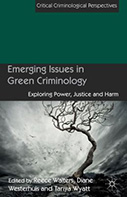Emerging Issues in Green Criminology: Exploring Power, Justice and Harm

Editors: Reece Walters, Diane Solomon Westerhuis, and Tanya Wyatt
Publisher: Hampshire, UK, New York: Palgrave Macmillan, 2013. 265p.
Reviewer: Christopher J. Moloney | January 2014
Green Criminology, as both: (1) a general perspective for examining the relationships between environmental issues and notions of harm and crime; and, (2) a broad field of research, is rapidly expanding. This fact is evidenced in any number of ways: in the creation of a Green Criminology website whose members hail from countries around the world; in the proliferation of special groups and sessions devoted to the topic of green criminology at criminological and sociological conferences; and, in an increasing number of published articles, books and edited collections that place green criminology and/or environmental crimes and harms front and center. Emerging Issues in Green Criminology: Exploring Power, Justice and Harm is an important new addition to the growing body of empirical and theoretical research devoted to exploring the boundaries of green criminology.
Edited by Reece Walters, Diane Solomon Westerhuis and Tanya Wyatt, Emerging Issues incorporates case studies exploring various environmental harms, crimes, laws and policies that deserve our increasing scholarly, and societal attention. Emerging Issues draws on a variety of scholarly voices with the stated aim of “responding to environmental issues of both global and local concern (1).” In their editors’ introduction, Walters, Westerhuis and Wyatt note that this goal is not met by simple description of “emerging” environmental concerns. Rather, the key distinguishing feature that sets Emerging Issues apart from other green criminology titles is its’ specific focus upon integrating the concepts of power, justice and harm into how we think about, and respond to green crimes/harms of various types.
Emerging Issues, therefore, also comfortably occupies a publicly engaged, even activist, space within the current academic discourse on environmental harms. This is an important contribution in itself with implications for how green criminologists do their work in the future. While Walters, Westerhuis and Wyatt frame their collection’s emphases on power, justice and harm in terms of broadening the theoretical boundaries of green criminology, it is clear that they believe—as do their contributors—that green criminologists have an obligation and enormous potential to contribute to achieving interventions and promoting positive social change within the realm of human/environment relations.
Emerging Issues is divided into 3 parts. While these parts are meant to be distinct, there is topical overlap. For example, wildlife trafficking and wildlife crime is the focus of 3 entries in parts II and III, out of a total of 12 entries in the entire edited collection. Wildlife crimes are certainly interesting and important issues, but one wonders if the collection might have been improved by inclusion of another case study or two on different “emerging” issues, in place of the three that deal with wildlife. And, for that matter, we might enquire if wildlife trafficking truly represents an “emerging” issue in the same ways that E-waste disposal or bio-fuel production do? As far as I can tell, wildlife trafficking has been a well documented, highly publicized, investigated and politically contentious environmental issue for many decades, garnering extensive public concern and policy intervention—and, perhaps most importantly, significant NGO involvement. My point here is not that Emerging Issues suffers because of its inclusion of multiple case studies about wildlife crimes, only that the collection may have been more powerful had it sought harder to push our empirical and theoretical boundaries about what the “emerging” issues are.
It should also be noted that for all the claims of a “diversity” of voices in Emerging Issues, the contributors hail from North America (3), Western Europe (9) and Australia (4). Again, it would have been nice—though not necessary—to hear from a true diversity of scholars, especially from non-western, developed and developing nations in a collection devoted to “emerging” issues, rather than simply hearing about those issues from the traditional Western, American, European and Australian viewpoints. Still, these quibbles are only minor ones with what is, overall, a very nicely conceptualized and successful collection. As far as the specific contributions in the chapters go, there are three I believe deserve specific mention for their important positive contributions to the discipline of green criminology.
First, Rob White’s chapter titled “The Conceptual Contours of Green Criminology” (Ch.1) is an absolute “must read” for all students and scholars interested in green criminology and environmental harms/crimes—even those people who are just curious about what green criminology is. White provides a concise, yet encompassing overview of green criminology including its origins and current status as a field of research.
One especially relevant aspect of White’s chapter is his discussion of the various perspectives within green criminology. From his point of view, green criminology is a grand perspective, or umbrella, containing various sub-perspectives, or branches—e.g., radical, eco-global, conservation, etc.—all of which take as their starting point issues of environmental harm or crime, but which differ significantly in their politics and, therefore, approaches to analyzing and explaining green crimes and harms. Green criminologists and others interested in exploring environmental issues ought to understand the nuances among these various stances. In addition, White’s chapter emphasizes the importance of political economy as a useful, though currently underutilized theoretical approach for developing insightful analyses and explanations of environmental harms from the local to global scales.
Lieselot Bisschop and Gudrun Vande Walle (Ch.2) also contribute an important discussion about environmental victimization. Framing their discussion of “environmental victimology” within a larger analysis of illegal e-waste transport and dumping, Bisschop and Vande Walle make the point that victims of environmental harms have been generally under-theorized in attempts to describe and explain green crimes. The authors argue this omission relates to the predominant focus within mainstream criminology and victimology on examining victimization in relation to the criminal justice system or victim’s rights. This preoccupation then obscures the true extent and ramifications that becoming a victim of an environmental crime have for individuals and communities, especially when the crimes or harms are “hidden”—as green crimes often are. The point here is that green criminologists moving forward need to focus on developing the “victims” in their narratives of green crimes, e.g., who they are, how they are impacted, the short/long term repercussions, and options for providing relief and/or possible conflict resolution.
Finally, Hanneke Mol provides an insightful chapter (Ch.12) where the connections between the “human and non-human” realm take center stage. Mol’s essential argument has to do with power and harm; specifically, the manner in which power wielded by human actors translates into issues of actual (and potential) environmental harm and crime with significant repercussions for the natural world, including non-human plant and animal species. Mol’s contribution should not be underestimated, since power—as Mol notes—has long been a cornerstone of critical criminological thinking and analysis.
Thus, it is within the tradition of incorporating and explicitly conceptualizing the role that power plays in producing certain inequitable—nay, criminal—outcomes, that Mol is engaging. And, this is, no pun intended, a powerful and important contribution, for power and harm are intimately connected. How often, however, have green criminologists published, or read works by other green criminologists, in which issues of harm are emphasized, but where concrete discussions of power, or the interrelation of power to harm, are ignored or merely assumed? The answer is too often. This is the crux of Mol’s piece—to urge green criminologists to more explicitly interrogate and highlight the collusion of power and harm in their analyses moving forward.
Certainly, other chapters in Emerging Issues in Green Criminology: Exploring Power, Justice and Harm deserve mention, but space will not allow. In this review, I have chosen to highlight only a few of the more important theoretical and empirical contributions from the collection whose impacts on the future of how green criminologists do their work are especially important.
Emerging Issues is a well rounded, nicely edited, accessible and concise contribution to the growing field of green criminology and it should find a home on the bookshelves of all green criminologists. The collection should also find practical uses in other criminology and criminal justice courses that incorporate discussions of environmental crimes and harms within their course plans. At the same time, it should be opened, repeatedly, and used as a resource to aid the development of future studies on environmental harms and crimes.
Christopher J. Moloney, Center for the Study of Crime and Justice, Colorado State University, Fort Collins, CO, USA, chris.moloney@colostate.edu


